Laron Howard: Burberry’s Marketing Manager on his Journey from Howard University to the Fashion Industry
October 8, 2020
Rashad Benton


It’s not often you encounter someone from Augusta, Georgia in fashion. Meet Laron Howard, the Howard University graduate leading Burberry’s marketing efforts as a Marketing Manager for the Americas. From a childhood in the deep south to studying Business Marketing at an HBCU situated in Washington, D.C., it was Howard’s journey throughout his undergraduate studies that led him to realize his genuine interest in a fashion career.
His first exposure to fashion came by way of his father, who owned a clothing boutique in Georgia. As a college student, an appetite for a career on the business side of the fashion industry was additionally influenced by P. Diddy, an alum of the same institution he was attending. If you know anything about life at an HBCU, you know fashion on campus is taken seriously. During his senior year, Laron produced Howard’s homecoming fashion show, an event he spent an entire year bringing to life. That experience and the positive feedback he received on the show pushed his desire to pursue a career in fashion. He knew the industry he wanted to work in though he wasn’t quite sure what a position in fashion would look like for him.
As the end of his undergraduate experience grew near, he realized how imperative it was for him to relocate to New York to pursue his dreams. A tour around Etro’s showroom and a conversation with Antoine Phillips, his close friend and mentor who is now the Vice President of Brand and Culture Engagement at Gucci, were defining moments in his life. Today, 11 years after college, he’s a seasoned veteran with an impressive resume that includes Tommy Hilfiger, Reebok, and Versace some of fashion’s most influential brands.
“Having been a part of organizations and companies that target the Black audience and then going into a meeting and realizing you’re the only Black person there is disturbing,” he said.
It isn’t every day that a background as captivating as this comes around and our talk with Laron did not disappoint.
How did you break into the Fashion Industry?
I secured an in-house internship at Versace in 2009 around the time the economy crashed. There were no jobs to be found, but I knew then that I had to move to New York if I ever wanted to make it in this industry. I informed my parents that I was moving for an unpaid internship and would figure out a way to supplement my income, even if I had to pick up a part-time job. The internship at Versace ran for six months, Monday through Friday, from sun up to sun down, it seemed.
During this time, companies were downsizing and the individual who was supposed to be my boss was let go due to the economy. This unfortunate circumstance allowed me to shine and converse with people I probably shouldn’t have met or engaged with as an intern. Versace really catapulted my career, and some of those people from back then still look out for me today. I then went on to become an assistant at Tommy Hilfiger before an opportunity with PR Consulting presented itself. At PRC, I went from coordinator to associate manager in PR and Events with a focus on lifestyle and stayed there for two years. After that, I joined Karla Otto to work with my previous boss from Tommy and invested five years at the company.
One of my first jobs was at Footaction as a teenager. My love for sneakers and streetwear still influences the way I dress today and my interest in the sportswear arena came back around, leading me to accept a Global PR Manager role at Reebok. The company’s headquarters are based in Boston, so I ended up moving. At Reebok, I created global campaigns and PR strategies. Not too long after, I was approached with a golden opportunity in marketing at Burberry. Riccardo Tisci was heading to the brand and I knew it was going to be a thrilling time that I couldn’t pass up. I accepted the position and moved back to New York.
What has been your most noteworthy achievement up to this point?
When I think of a noteworthy achievement, it’s not in the traditional sense of me rolling out this fantastic campaign or placing this beautiful editorial in Vogue. My most noteworthy achievement is an idea I developed at Reebok. I pitched the concept of having Reebok go to Howard University and sponsor the School of Business. I remember seeing all these companies come to Howard to recruit students, and for someone interested in fashion, I recall no one from that space ever being present.
I always told myself that whenever I reached a place in my career and got to a company where I could go back and offer opportunities to students, I would do that. Many undergraduates at Howard are interested in pursuing careers in fashion but aren’t aware of how to make this a reality. Watching the idea come to life after pitching it to my HR partners and executives at Reebok became the achievement, I’ve been incredibly proud of making happen.
Have you felt celebrated in your present job or any of your past positions?
There have definitely been moments of celebration. There is something very special that happens in the workplace when the people around you have different points of view and cultural references or experiences. Folks are surprisingly eager to understand what that means and learn from it, which is encouraging. Does this mean they will dive deeper into the subject and make it part of a strategy? Perhaps not, but I do think there is sometimes an interest and a celebration of the culture, my culture.
Have you felt ignored or left out of an employment opportunity because of the color of your skin?
[Laughs] Of course, I have. I think we all have experienced that in this industry. It is important to not let that stop you and keep pushing for what you want, the right opportunity will come where your value will be seen.
What should be done for Black individuals in this industry, or what might you want to see for Black individuals in fashion?
One of the first things is establishing a pipeline followed by opportunities…the creation of access points for Black people so they can identify what these opportunities look like and where they live. The enormous economic gap needs to be addressed in terms of being able to pursue a career in this field. You know, for the first three years, you are typically not making any real money.
Many Black people don’t come from trust funds and can’t afford to go to New York and work for pennies for a few years. We need something that will offset that, and I’m not sure what that is, but companies need to figure out how to establish a space economically that is friendly for everyone – not just for someone from a wealthy background. The idea of diversity and inclusion is another issue I want to address. We want measurable results! Sure, you may be hiring diverse candidates, but are you allowing them to have a voice? If not, you’re doing nothing but hitting a quota. Support us with upward mobility. If someone starts as an assistant, how will companies ensure that Black talent is given an upward mobility path to become the next Manager or Director?”
In your opinion, what is the nature of fashion like for Black people or People of Color?
Fashion is an industry that really loves the idea of Black culture and incorporating it from an image perspective, externally. Realizing that so much of the business comes from Black people and being someone on the inside is sometimes challenging. Having been a part of organizations and companies that target the Black audience and then going into a meeting and realizing you’re the only Black person there is disturbing.
Being the only one is a complex position to be in within this industry, especially when brands are targeting our community. A lot of these companies value our money and culture but don’t appreciate individuals from the community enough to represent us internally.
How have you given back to your community through your position?
I am incredibly proud of what we were able to do with The New Black Vanguard project. I met with Antwaun Sargent who created the book and presented this brilliant and relevant idea to me. It was terrific to see these young Black photographers highlighted. These photojournalists are the people behind the images that everyone is referencing right now and creating what fashion looks like today. I was extremely keen on imagining how Antwaun and I could work together, and finding a way to support the project and bring it into Burberry.
Furthermore, I found interest in supporting the artists in the book and did this by bringing them closer to the brand. Previously, they had not received chances within particular spaces, and knowing I could assist them was rewarding. I don’t look at this as “giving back.” It was more about highlighting a story that needed to be told.
Not long ago, I spent time with Misa Hylton and her students at her Fashion Academy. Establishing opportunities for the generation after me is constantly on my mind, which is why I’m on the Diversity and Inclusion Council at Burberry.
Are there any Black Designers known or unknown that you would like to bring to the CFDA attention?
I absolutely love what Kerby Jean-Raymond is doing at Pyer Moss. He’s an extremely great storyteller in terms of highlighting us and conveying that on a garment. FENTY! What Rihanna and Jahleel Weaver do over there is amazing, and to be the first Black women to lead and be a shareholder of an LVMH brand is a tremendous accomplishment. How those two are placing a spotlight on blackness through their platform is extremely important. Christopher John Rogers and his elegant take on Black women… seeing a Black man creating this for our people is incredible. I love Lourdes by Andreas Aresti. Oh, and Shayne Oliver is back and it is so exciting; He and Hood By Air are such an essential piece to our culture.
What are some of the things you think the CFDA should do to improve diversity and inclusion?
There’s a focus on young designers and I witness how they support and provide them with platforms. However, I believe there needs to be a layer of added support to make sure these designers are able to create a substantial business. Perhaps it is about giving designers access to people on the business side, in marketing, wholesale, retail, etc. so that they can compete in this industry. I also think it is important to highlight the other opportunities within the industry outside of the obvious ones, which is why I felt this interview was super important. It offers a chance for a different story to be told and to show people there are other avenues and career paths you can have within fashion.
PHOTO BY CHAD BALKUM

